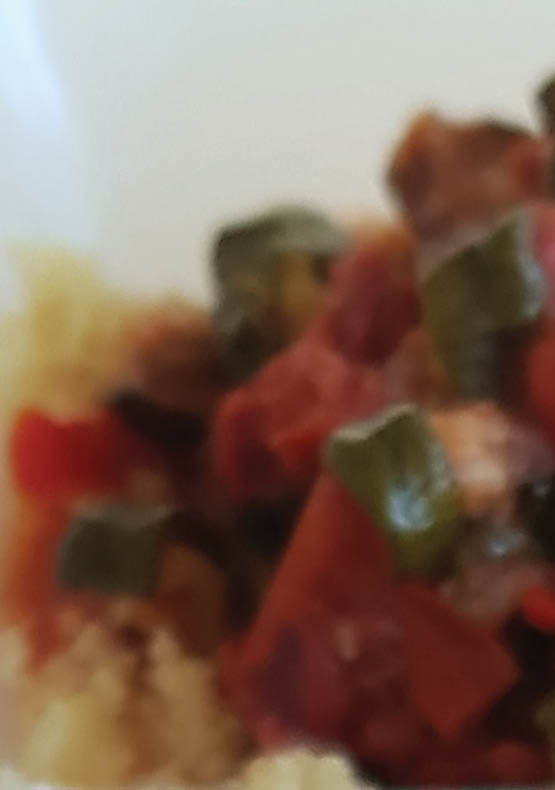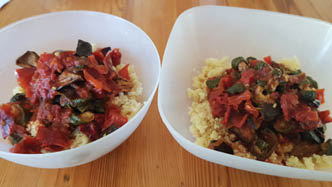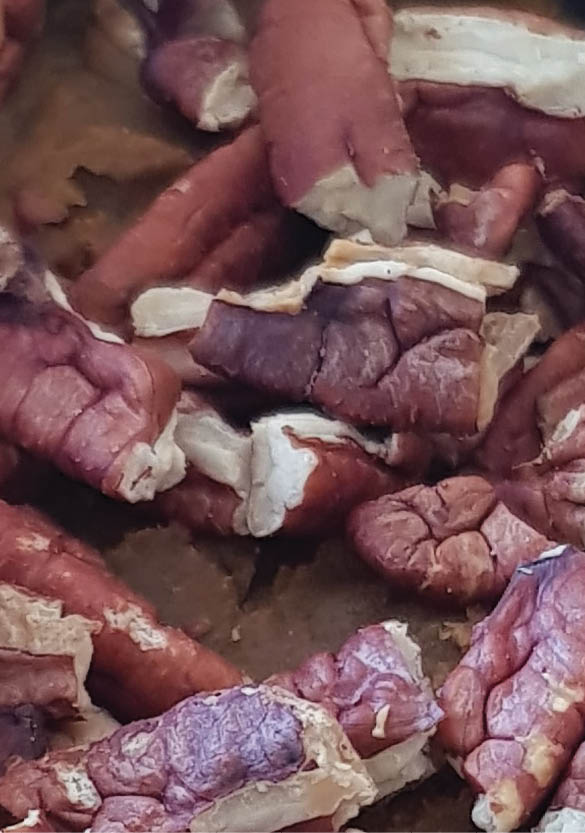

Dehydrated Delights
Sonya Muhlsimmer



Now is about the time I start preparing my meals for my annual back country pilgrimage to the snow. I have been searching through some old favourites and also looking through some ideas I have written down, yet to be formally written. I came across these two meals that are healthy, hearty and delicious. Time is required to cook, dehydrate and condition the meals, so go on and get in the kitchen and start preparing. Conditioning is placing the dehydrated meal into an airtight glass jar for a week to look for condensation, ensuring all the dehydrated food is fully dry at the same humidity level so mould won’t grow.
I have tried these dishes a few times and enjoyed them in trials at home, so why not give them a go in the snow? Having a good serving of vegetables when you are on a multi-day trip anywhere is pretty good, your body and taste buds will thank you. Oh, I will also show you a method to rehydrate the meals that you won’t even have any dirty dishes left behind to wash up, except for a bowl or two. Seriously, there is nothing better than having a hearty meal and dessert in the middle of nowhere and you don’t have to clean up, how good is that. This is what I call real soul food.
Camp site just outside the catchment zone near Blue Lake, Kosciuszcko NP, NSWAll pictures by Sonya Muhlsimmer
56 | BWA August 2021


Ratatouille is a classic French stew consisting of slow cooked vegetables in a rich tomato sauce. This is comfort food right here, ratatouille is a vegan and gluten free dish on its own, and anyone can eat it. Of course it depends on what side dish or accompaniment you have with it, you can serve it with cous cous, (which I will use for this article), rice, pasta, polenta, quinoa or even some flat bread. There are so many versions and recipes of this dish out there and you can either bake it or stew it. All you need is some good quality vegetables like eggplant, tomato, zucchini, capsicum and some herbs and spices. The traditional way is to saute each vegetable separately, then layer the vegetables in an oven dish and bake it, but we will be doing it a little differently, then it needs dehydrating. This meal serves two people.
Bag 1 (Ratatouille)
Eggplant (1 each)
Approx 200 grams
Zucchini (2 each)
Approx 250 grams
Red capsicum (1 with seeds removed)
Approx 200 grams
Dried herbs (oregano, thyme and basil)
2 pinches each
Vegetable stock
1 tsp
Crushed garlic
1 clove or tsp
Olive oil
2 Tbsp
Salt & pepper
Pinch
Diced tomato (1 can)
400 grams
White sugar
1 tsp
Bag 2 (Cous Cous)
Cous cous
2/3 cup
Vegetable stock
1 tsp
Salt & pepper
Pinch
Water
Water
2½ cups
At home methodCut the eggplant in uniform squares at approximately 2 x 2 centimetres diameter and place the eggplant in a colander in the sink. Sprinkle some salt over the eggplant and let sit for about 30 minutes, after this time rinse the eggplant in water to remove the salt. This
removes the bitterness from the seeds of the eggplant. In the meantime cut the remaining vegetables in a uniform size of around 2 x 2 centimetres. Pour the olive oil on the bottom of a baking tray, Place the vegetables on the tray, sprinkle with salt, pepper, chilli, herbs and garlic and mix the vegetables around so they get coated with the oil. Roast the vegetables in the oven at 180 °C for 30 minutes. While the vegetables are in the oven, open a 400 gram can of diced tomatoes and sprinkle a teaspoon of sugar in the can. When the vegetables are roasted, pour the can of tomato over the roasted vegetables, mix through and bake for another 30 minutes. This will weigh approximately 600 grams. Once cooked, spread the mixture over two dehydrator trays lined with baking paper, or if you have a dehydrator with solid trays lining the trays is not necessary. Dehydrate at 70 °C for about 15 hours. Look at the instructions of your dehydrator to set the temperature correctly as it could either have Level 1, 2 or 3. Then when the Ratatouille is dry, break it up and place it in jars and let sit for about a week to condition the meal. Then, place it in a snap lock bag and label as Ratatouille - Bag 1. The dehydrated weight is approximately 100 grams. Place the cous cous, salt pepper and stock powder in another bag and label this Bag 2.
At camp methodTo rehydrate, boil 2.5 cups of water. Add 3/4 of a cup boiled water to cover the cous cous then seal the bag. Add about 11/4 cups of the boiled water to the ratatouille bag, seal the zip lock bag closed and mix the water through by lightly squeezing the bag. The bags do not melt! Place the two bags into the remaining water in the pot, cover and let sit for around 10 minutes. When the ratatouille is rehydrated, add the cous cous to the bowl and pour the ratatouille over the cous cous, enjoy.

Roasted Ratatouille with Cous Cous

BWA August 2021 | 57



So who does not love a great dessert? And who does not love a quick and nutritious dessert at that? Let me tell you a little bit about the humble sweet potato. This vegetable is full of fibre and vitamins A, C and B6, which is great for the immune system, iron absorption and forming of red blood cells. There are also a lot of minerals such as potassium and folate which helps muscle function and forming of red blood cells and calcium to strengthen bones. Magnesium is also found in the sweet potato which helps with over 300 chemical reactions in the body such as contracting muscles, sending and receiving messages and keeping your heart beating just for some examples. For a humble root vegetable it sure packs a nutritious punch. Oh by the way, on a side note magnesium can also be taken to aid in muscle cramps. This dessert is pretty simple and tasty with a hint of sweetness and crunch for some texture. To have a super healthy vegetable made into a dessert is the best of both worlds I say. This dish also serves two people.
At home methodPeel and dice the sweet potato into approximately 3 x 3 cm cubes. Boil for about 15-20 minutes until the sweet potato is soft and cooked through. Drain into a colander and let cool, then place it into a blender with all the other ingredients except for the pecans. Puree the mix for about one minute then scrape down the sides of the blender with a spatula. Puree again for about 15 seconds until fully mixed through. This will weigh approximately 540 grams. Spread the mixture over two dehydrator trays lined with baking paper, or if you have a dehydrator with solid trays, lining the trays is unnecessary. Dehydrate at 70 °C for about 15 hours. Look at the instructions of your dehydrator to set the temperature correctly as it could either have Level 1, 2 or 3. Then when the pudding is dry, break it up and place it in jars and let sit for about a week to condition the meal. Now this should weigh approximately 140 grams. Once conditioned, place the sweet
potato in a food processor and grind it to a powder, this will help with rehydrating out on the trail. Then, place it in a snap lock bag and label as Sweet potato pudding - Bag 1. Toast the pecans and once cool crush them up slightly and place them in a bag labelled Topping - Bag 2.
Method at campBoil 1.5 cups of water. Add about 3/4 cup of water to the pudding bag and seal the bag closed. Mix the water through the pudding by lightly squeezing the bag. Soak the pudding mix in the pot with the remaining water for about 10 minutes. After the soaking time, mix thoroughly and serve in bowls, pour the pecans over the pudding and enjoy.
Bag 1 (Sweet potato pudding)
Sweet potato (2 medium)
Approx 540 grams
Treacle
3 Tbsp
Mixed spice
1 tsp
Coconut milk
½ cup
Vanilla essence
½ tsp
Bag 2 (Topping)
Pecans (toasted and crushed)
½ cup
Water
Water
1½ cups
To read more about the author or find delicious recipes check xtremegourmet.com
Treacle Sweet Potato Pudding

58 | BWA August 2021